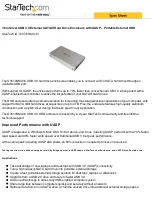
Chapter 3 OEM7 Receiver Operation
CPT7 and CPT7700 Installation and Operation User Manual v9
43
remember that even if you set the bps to 9600, the actual data transfer rate may be lower and depends on the
number of satellites being tracked, data filters in use, and idle time. It is therefore suggested that you leave
yourself a margin when choosing a data rate.
The minimum suggested baud rate for most applications is 115200 bps for GNSS only or 230400 bps
for GNSS+INS. If the buffer overrun flag is present in the
RXSTATUS
log (refer to the
Commands and Logs Reference Manual
), log at a higher baud rate if possible, or change to a
medium supporting higher bandwidth (USB or Ethernet).
Although the receiver can operate at data transfer rates as low as 300 bps, this is not recommended.
For example, if several data logs are active (that is, a significant amount of information needs to be
transmitted every second) but the bit rate is set too low, data overflows the serial port buffers, causing
an error condition in the receiver status that results in lost data.
The following ports are supported and can be configured using the commands listed. Refer to the commands
listed in the
OEM7 Commands and Logs Reference Manual
for detailed instructions.
Receiver Type
Port Supported
Configuration Command
CPT7
COM1, COM2
SERIALCONFIG
Table 9: Serial Ports Supported
Change the COM Port Settings
To change the settings on a COM port, use the
SERIALCONFIG
command. For example:
l
To change the data rate of COM2 to 115200, enter:
SERIALCONFIG COM2 115200
l
To change the data rate of COM1 to 57600 and enable even parity, enter:
SERIALCONFIG COM1 57600 E
Communicating using a Remote Terminal
One method of communicating with the receiver is through a remote terminal. To communicate with the
terminal, the receiver requires only the RX, TX and GND lines be used. Ensure the terminal’s communications
set up matches the receiver’s port settings.
Communicating using a Computer
A computer can emulate a remote terminal as well as provide the added flexibility of supporting multiple
command batch files and data logging storage files. Use any standard communications software package that
emulates a terminal to establish bidirectional communications with the receiver. Examples include NovAtel
Application Suite and PuTTY. All data is sent as raw 8-bit binary or ASCII characters.
Refer to
Communicating with the Receiver
on page 45 for details.
3.1.3 Ethernet Communications
The CPT7 is equipped with a 10-Base-T/100-Base-TX Ethernet port that supports IPv4 Internet layer, TCP/IP
transport and telnet. Users can conduct remote debugging, accept MRTCA (modified RTCA) data and update
Содержание CPT7
Страница 102: ...Chapter 4 SPAN Operation CPT7 and CPT7700 Installation and Operation User Manual v9 102 Figure 31 Sample Configuration ...
Страница 185: ...APPENDIX E Importance of Antenna Selection CPT7 and CPT7700 Installation and Operation User Manual v9 185 ...
Страница 186: ...CPT7 and CPT7700 Installation and Operation User Manual v9 186 ...
















































